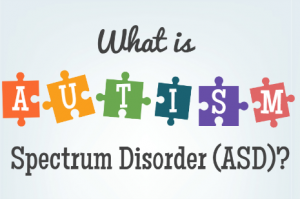Autism Spectrum Disorder and Speech Therapy

“Autism, or autism spectrum disorder (ASD), includes a broad range of conditions that are characterized by challenges in children and adults with social skills, repetitive behaviors, speech, and nonverbal communication. Autism is not a speech or language disorder. It’s a social communication disorder.
These children show delays in acquiring language, which ranges from the absence of functional communication to limited language development. Also, they show a problem in the use of language in conversation with people. They are often non-verbal when initially diagnosed by a Speech therapist. Any speech if present is usually limited and inconsistent. Their speech appears abnormal and is often described as machine-like, “monotonic,” speech
A child with autism spectrum disorder shows difficulty in communicating with people. Language development in most children with ASD is usually delayed and in a few children, there is no language at all.
Communication is a two-way process that uses eye contact, facial expressions and gestures as well as words, children with ASD don’t understand this. Some children with ASD develop good speech but can still show difficulty in knowing how to use language with other people. They might also communicate mostly to ask for their basic needs, rather than for social reasons.
They often use language in unusual ways to use while communicating and interacting with people. For example, echolalia is a common feature in children with ASD. This is when children imitate words or phrases without meaning or in an unusual voice. They might repeat someone’s words immediately or later on. They might also repeat words they’ve heard on screens (TV, Mobile phone, etc) as well as in real life.
Some other features like Neologism making up new words without or with meaning, which are called neologisms, they might say the same word again and again which is called neologism, they get confused while using pronouns and refer to themselves as ‘you’, and the person they’re talking to as ‘I’.
Nonverbal Communication
These ways of communicating might include: children with ASD prefer to use nonverbal communication. It includes pushing others towards the desired object, dragging others’ hands towards what they want, pointing, showing and shifting eye gaze – for example, a child looks at something he wants and then moves his gaze to another person, letting that person know he wants that object.
The major characteristics of autism are abnormal speech patterns which includes
- 1. Repetitive or rigid language
- 2. Limited interests and exceptional abilities
- 3. Uneven language development
- 4. Poor nonverbal conversation skills
Language Characteristics:
Individuals with autism spectrum disorder may:
They have limited vocabulary and use them based on their utterances.
- In some instances, they repeat bits of dialogue heard on television or in the conversation of others. But they do not use them in an appropriate context.
- Appear to have some difficulty grasping the main idea and they cannot draw any conclusions.
- They have difficulty in understanding and expressing “WH” question forms such as Who, What, Where, When, Why, How and others.
- They appear to focus on keywords rather than the whole sentence.
Social Communication:
- They have difficulty in seeing another person’s perspective.
- They give no or minimal eye contact during an interaction.
- They speak too loudly or too fast while communicating for their basic needs.
- They show difficulty in staying on one topic and may get distracted easily.
Other Characteristics
- Have difficulty with fine motor skills, especially handwriting and holding objects in the right way.
- They like to be isolated.
They are tuned to a routine and cannot adjust easily for the changes made.
Strategies for promoting language development in nonverbal children
- Encourage play activities and social interaction.
- Imitate what the child says and motivate him to speak with rewards and reinforcements.
- Provide opportunities for the child to speak.
- Simplify language by using phrases with varied intonation.
- Follow the child’s interest and enhance his learning skills.
For more details contact
us on 📞9618906780
